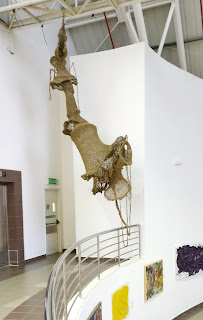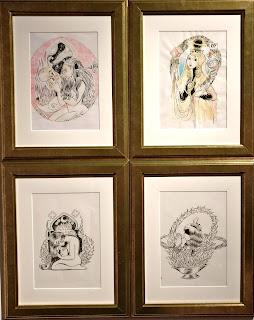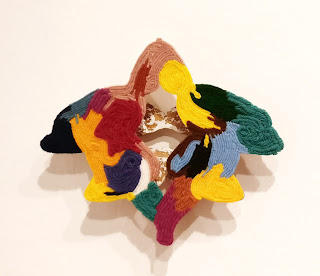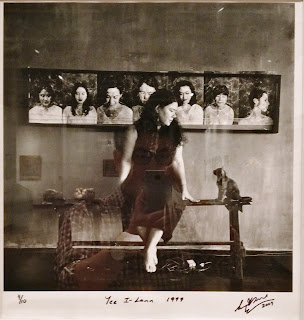Di Mana (Where Are) Young @ National Art Gallery
Visitors ascending the spiral walkway to the third-floor galleries are in for a treat. Walking past well-executed paintings – some surreal figurations, some abstract expressions – one is greeted by a large marionette made from jute ropes. Lisa Foo’s aptly-titled ‘Being in the Moment’ grants playful freedom; Otherwise one can slingshot chalk onto a classroom blackboard, duck and run through a geometric-shaped passage, sit on beautifully-designed rubber wood bar stools, lie down inside a bulbous plastic bag (with a fan blowing inside), or engage in a game of Chinese chess with trapezoidal constructs as moving pieces. Within the smaller gallery hangs a floral wreath made from plastic bottles, while a comic strip about Kapitan Yap Ah Loy is encased in an acrylic box nearby, and a collection of repurposed biscuit tin cans and small framed drawings is arranged in one corner of the gallery.
 |
| Installation view of Lisa Foo – Being in the Moment (2017) |
I appreciate Anna Azzreena’s quirky observations about sitting poses. I laugh out loud at ‘My Language Proficiency’ by Okui Lala, a video of the artist having a conversation with her selves in English, Mandarin, Bahasa, and Hokkien. I indulge in the spectral yet lively figures in Hamidah Abdul Rahman’s ‘Kitaran’. I marvel at clay ‘Globe’(s) by Ham Rabeah Kamarun, its caked and hardened surfaces reinforcing its status as tactile art objects. I watch stoically at Sharon Chin throwing flowers forcefully onto the tarmac in the recorded performance ‘Ria/Joy’. I was struck in awe by Mah Chai Soon’s ‘Labourers’, a sketchy watercolour painting made in 1966, and collected by Balai the following year. Even after admiring crafty and colourful textile works by Ani Emina Azman and Yim Yen Sum, there remains no obvious hint that I am looking at artworks done exclusively by women artists.
| Video snapshots of Okui Lala – My Language Proficiency (2017) |
Only after coming across the word Anxiety on a wall near the larger gallery’s entrance, did I pay attention to the "women artists only" aspect of this exhibition. Several questions spring immediately to mind regarding the exhibition theme. For one, specifying a gender reinforces clichés associated to “women’s struggles”, i.e. women artists receiving less recognition, woman as child-bearer and primary care-giver, feminist beliefs that challenge social norms, etc. Secondly, the exhibits are culled from multiple sources – the national collection, works chosen by artists already represented in the national collection, artists invited by the curator, and an open call (which includes five students). This haphazard selection resulted in 101 women’s artists, which number is retained in the exhibition title to imply an introduction or primer.
 |
| Liu Siat Moi – Self Portrait (1963) |
Given that its exhibits are sourced from various channels, and only one curator involved, it is unfair to expect a coherent show. The result is a sprawling presentation with some complementing works shown together, some sections that reinforce clichés, some works which seem better suited for another exhibition within the same building, and some rarely seen gems from the national collection. As indicated by statistics presented outside the gallery, institutional recognition is the key theme. For the 2006 exhibition “Holding Up Half the Sky by Women Artists”, a survey done only with pieces from the national collection, curator Laura Fan stated that, “(e)ven with the collection, there may be several women artists who have been overlooked either because their names were not recognized…” This is true as my favourite Malaysian female contemporary artist was not included among this 101.
 |
| Sarah Joan Mokhtar – Untitled I, II, III, IV (2012) |
Putting aside the definition of “women’s struggles”, many works project a keen sensitivity that is less apparent in works by local male artists. There are images that reinforce the artist’s gender, such as Yee I-Lann’s portrayal of seven women in the arts, or the four beautiful Celtic-inspired illustrations by Sarah Joan Mokhtar. There are masterful usage of materials, such as Jasmine Kok’s fantastical ceramic and velvet wall sculpture, or the small gesso and wool ‘Object 006’ by Naomi Ching. There is a pair of dense, personal, and brilliant paintings hung side by side, by Eng Hwee Chu and Anna Chin. Special regard is accorded to the video record of Intan Rafiza’s 2012 performance at Chow Kit, and Ruby Subramaniam’s photo series of dancers in body paint posing in Brickfields. These two works approach the theme of body politics with aplomb, and should be celebrated for making its way into the National Gallery.
 |
| Naomi Ching – Object 006 (2015) |
Which leads me to the most interesting exhibits here – pieces from the national collection, especially those acquired in the first 30 years since its inception. I wonder about the life and times of Katherine Sim, whose portrait of ‘Salmah’ is dated 1948 and was collected in 1959. Liu Siat Moi’s casual ‘Self Portrait’ is hung on the same wall as a 1968 painting by Nora Abdullah, the latter an accomplished comic artist whose 1956 illustrated book was acquired by the British Library. The most stunning work belongs to Rokiah Yusoff, whose ‘Pasangan Melayu’ is a collage consisting of painted cut-outs, rattan placemats, lace, and magazine snippets. With its printed words, awkward figures, and crafty patterns, the work recalls a combination of Richard Hamilton and Ismail Zain, while offering a fresh take of a local subject matter. Google has not yielded a single piece of information about Rokiah Yusoff, the artist.
| Rokiah Yusoff – Pasangan Melayu (1963) |
Institutional recognition remains a pressing question, when one wonders why a work as significant in Malaysian art history as Nirmala Dutt Shanmughalingam’s ‘Statement 1’ – a breakthrough in social commentary art – is not included in the “Negaraku” survey downstairs. In another article, I read about Sivam Selvaratnam remarking about the importance of institutional acquisitions during the 1960s & 70s, especially for works by women artists which were less popular with private collectors. While there is not sufficient information here to trace a lineage of women’s artworks in Malaysian art history, the wide-ranging works in this exhibition demonstrate that the fe/male binary is less apparent than what one first expects, and that can only be a good thing. It is a real-life translation of the wonderful “MyWomen’sArt” Twitter account, and a celebration of good, diverse art.
 |
| Soraya Yusof Talismail – Yee I-Lann (1999) |
Comments
Post a Comment